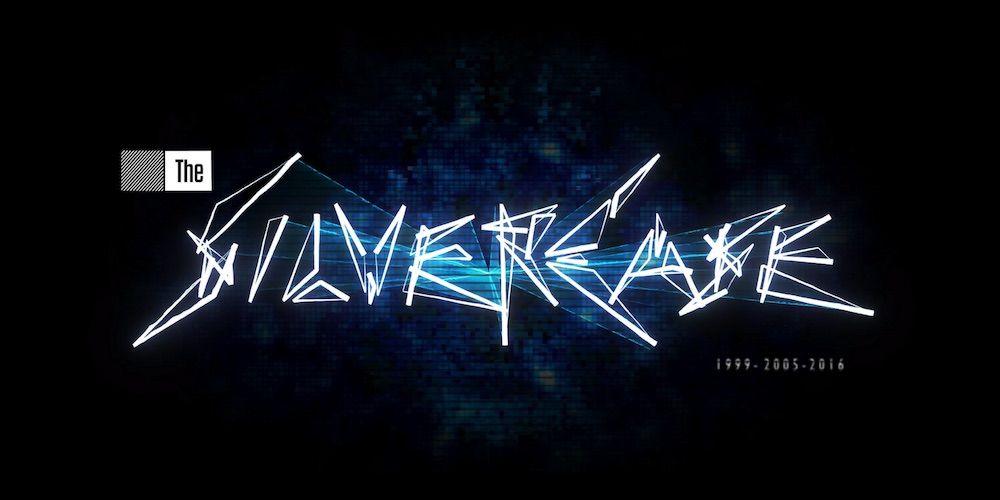
Suda51 (real name, Goichi Suda) is an interesting fellow from Japan. Notable these days for his games company, Grasshopper Manufacture, works of his that you might be aware of include Killer7 and the No More Heroes series. Always pushing a mix of dark but also comedic themes, his games also stand out because of their outlandish visuals and over the top dialogue.
I don’t think there is a games creator out there who has more split opinions about him than Suda51. The gaming public either think he’s the bee’s knees or a complete hack. I for one had never played any of his games previously, so, The Silver Case was my first impressions of him. If it’s anything to go by – let’s just say that you never forget your first Suda51 game.
Many may not be aware of The Silver Case, however, which debuted on the original PlayStation in 1999 and was his first game. The original Silver Case never made it to western audiences, unfortunately, due to localisation and translation issues (Grasshopper Manufacture was quite small at the time after all). A remake was attempted in 2007 on the Nintendo DS – however, Suda51 was not happy with how the localisation was going for that either, so he canned it. It wasn’t until 2016 that us English-only speaking folks finally got access to a translated HD remaster on Steam and then the PSN this year.

The Silver Case is a crime thriller with its gameplay fitting somewhere between the adventure genre and reading a visual novel. It’s played in two roles – one of yourself in-game as a speechless detective investigating a series of bizarre killings, as well as a journalist who’s following and reporting on the same events. Set in an alternative Japan in 1999, the gameplay is ‘sit and watch’ rather than ‘sit and interact,’ although there is some light puzzling and a bit of exploring involved.
The majority of the game revolves around sitting and reading copious amounts of text, however, and for some this will become quite tiresome. The story is, for the most part, engaging but can also drag on – it seems that a lot of the dialogue was purposefully elongated to extend the games life. Every sentence will require you to push X to proceed to the next, with some conversations going back and forth like: “Are you sure?” “Yes.” “But really, are you sure?” for minutes at a time. You’ll at least get really good at speed reading (who said games don’t benefit real life skills?) as you pound the X button just to move things along.
Not to say this is always the case, though – there were other times where the game was tugging on the ole’ heartstrings, heavily and vehemently pulling me into the rich and deeply constructed world that Suda51 has created. The man sure knows how to write a captivating story, that’s for sure, but I really wished it didn’t lag constantly. Plenty of tedious and dull moments could easily have been omitted for a generally smoother experience.
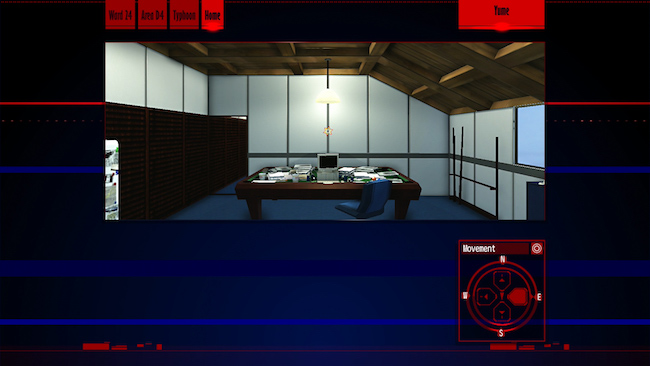
The whole game isn’t solely like reading a comic, though (although a large portion of it is), with the other half of the game taking place in a rectangular window in the middle of the screen. While odd at first (it doesn’t seem vertical enough and blocks large portions of your field of vision), it’s surprisingly easy to get used to despite being restrictive. This is where the ‘adventure’ parts come into play, which take place in sparsely detailed 3D environments. You can’t wander around these at will either as the game takes an ‘on-rails’ approach going from one part to another. Since the environments are so empty, each point you travel to has its importance represented by different symbols.
This approach can subtract from the overall tone the story is trying to convey. While the text parts are coupled with detailed drawings and sometimes even full motion video, the empty 3D environments are lifeless. I don’t want to give too much away about the plot since it’s the main draw to play, but since the game is about a serial killer, there are times you’ll naturally stumble upon dead bodies. However, in the 3D environments, you can’t see these corpses (or whatever, but mostly corpses) since you’re not aware of their existence until you activate a point with a particular symbol. It’s here that the illustrations and videos are shown, but when finished, the game goes back to the empty room. All this does is constantly pull you in and out of being immersed in the fantastic story. There aren’t even any fellow characters shown – only a thumbnail of their face if you’re in a location where you can interact with them.
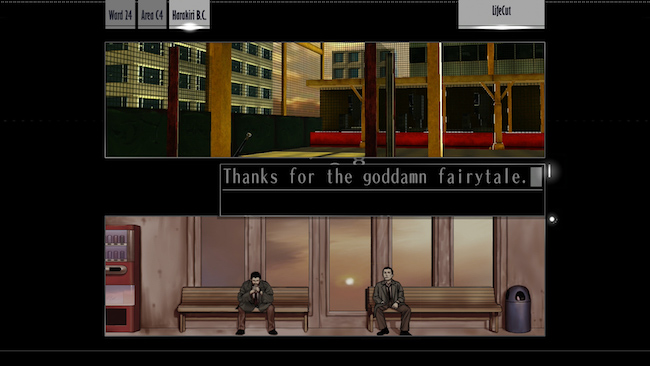
While I encourage the fact that the game tries to throw in some puzzles to prevent The Silver Case from entirely being a walking simulator and an interactive book, it’s a shame that they’re weak additions. Early on there are some simple number puzzles, but after that everything is based around exploring the environment. Frustratingly, these usually involve nothing but searching multiple rooms in large complexes. These missions are boring and long and are another example of the game trying to bloat its length.
Also, pro tip: If you’re stuck, look up or down. This caught me out several times since you seldom need to. One part that did take me by surprise, however, was a random pop quiz about half way through the game. This was quite lengthy, timed and mostly based around late nineties Japanese pop-culture – but hey, I passed. I can’t complain.
As you can imagine, The Silver Case is quite a linear experience. It has a story to tell and unapologetically does it from A to B. However, it’s nice that the story is somewhat mixed up by alternating between the detective and journalist’s stories. While following the same timeline, the journalist’s events take place slightly after the detectives. It’s kind of nice that you get retold the story again from a different perspective as it gets fairly complex at some points and makes it a bit more digestible.
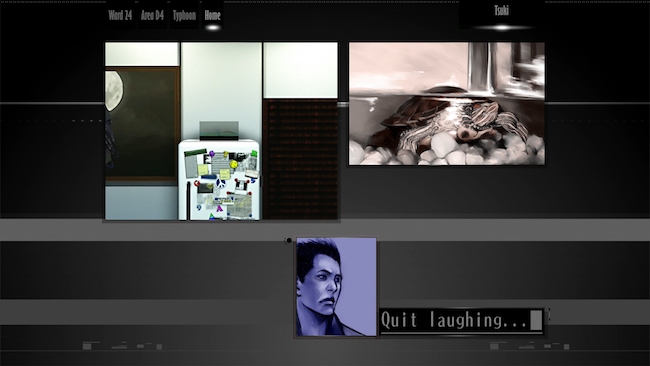
The gameplay for the journalist’s story arc can be even more tiresome than the detectives, however, since his life basically involves standing in the middle of his room, moving to his computer or phone, reading some emails followed by cutscenes of him moaning to a bartender while getting drunk or hassling detectives for information. It goes in a cycle – once the mandatory cutscene is over, it’s back to his room where you move back to the computer and do it all again. It rarely deviates from this, although, here’s another pro tip for you: If you do get stuck, talk to his turtle.
The art style used throughout this game is somewhere between a mid-morning educational show on the ABC in the ’90s and Deus Ex. The barren 3D environments are of course excluded from this, but everything else from the art stills to the various patterns on the border of the 3D environment viewing box (there is a better name for that, I’m sure) has obviously been made with care and plenty of thought. Each mission has a distinct look too, which rolls with the music.
The music is definitely one of the highlights, too. Like the visuals, it changes from mission to mission reflecting the mood and atmosphere of the content. The Silver Case was made on a very tight budget with quite a small team (which is why there is likely no voice acting and hardly any interactive content), but it’s quite clear that they went all out for the music – and since that’s what you mostly listen to throughout the game, I’m grateful.
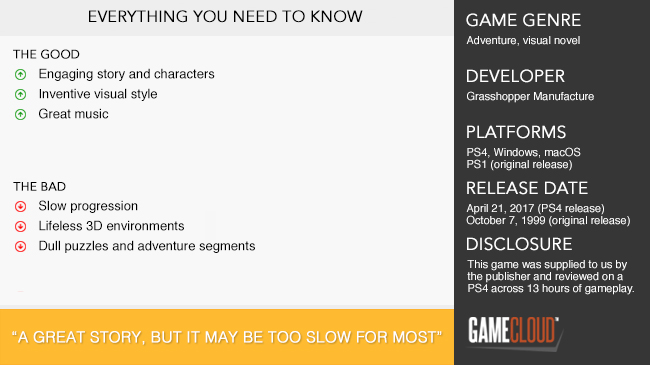
While The Silver Case has a (mostly) enthralling story, an engaging setting as well as fantastic music, it can’t be completely saved because of just how slow it feels. There are large parts of the game where you’re just sitting there – and when the game does ‘reward’ you with interactive content, it just doesn’t seem enough. It’s either boring, repetitive or plain pointless. At one point later in the game, you’re required to search ten identical towers, going from identical room to identical room (of which each tower has half a dozen) just to find a few scraps of ‘clues’ that let you pass a simple number puzzle. This takes over half an hour to do and is as tedious as you can imagine. In that case, I probably would have just preferred more cutscenes and text. I might be impatient, sure – maybe this game is simply not for me. Likely there are plenty of gamers who wouldn’t mind sitting through 13 hours of mostly text and dull gameplay just to experience the story – but alas, I play games to interact and have fun. The Silver Case does neither for me. Sorry, Suda.











